SpreadJS V17 Crack
SpreadJS V17 has many new exciting features and two new optional addon components:
NEW! GanttSheet Add-On
We are proud to introduce the new optional?GanttSheet Add-On! This new sheet type is essentially a full Gantt implementation inside of SpreadJS, allowing you to create Work Breakdown Structures and Production Schedules, just to name a couple. It is a fast, data-bound DataTable view with Gantt Chart behavior and a spreadsheet user interface. Using GanttSheet provides several benefits:
- Visual Planning: Provides a clear visual representation of project tasks, timelines, and dependencies, making it easier to plan and manage projects effectively.
- Task Dependencies: Allows you to define and visualize task dependencies, helping you understand how different tasks are linked and the impact of delays on the overall project timeline.
- Progress Tracking: Tracks the progress of each task and the overall project by marking completed tasks and comparing them with the planned timeline.
- Deadline Management: Enables you to set and manage project milestones and deadlines, ensuring that the project stays on track and is completed within the specified time frame.
You can also manage tasks, sort, change calendar settings, and even import and export to SSJSON, SJS, and Excel.
?
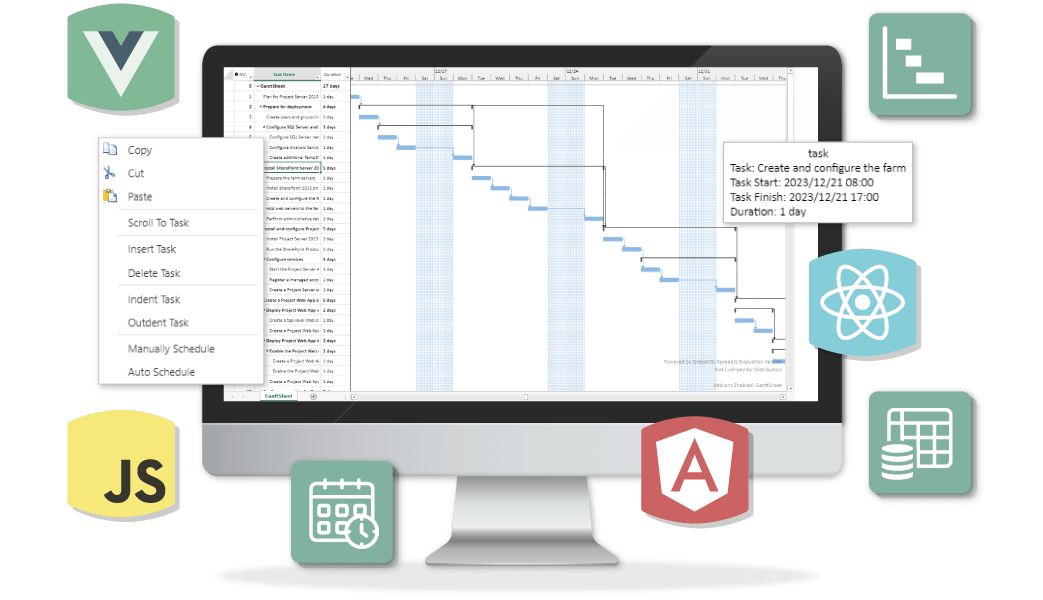
SpreadJS V17 marks the introduction of the new optional?ReportSheet Add-On! This new sheet type for SpreadJS supports creating and managing reports. These reports can be important for creating marketing strategies, travel reports, sales track reports, employee reports, and more. Usually, this can take a lot of time and effort to put together, but ReportSheet makes it a simple and flexible process. This new add-on supports data entry, pagination, data filtering, sorting, and conditional formatting. Using ReportSheet can provide a lot of benefits to your application:
- Integrated Template and Data Management: Allows seamless integration of report settings and data with the combination of ReportSheet and?TemplateSheet. The TemplateSheet holds various report-related settings, which ReportSheet utilizes, alongside data from DataManager, to generate corresponding reports efficiently.
- Enhanced Flexibility: Provides highly flexible syntax and API to bind source data. It follows easy data population rules in fields and also provides data entry APIs.
- Ease of Customization:?Ensures a standardized format and appearance for all generated reports, maintaining consistency across various data sets.
- Comprehensive Data Handling Features: Manage and present data in a user-friendly manner. ReportSheet is not just about report generation; it's a comprehensive tool that supports data entry, pagination, data filtering, sorting, and conditional formatting.
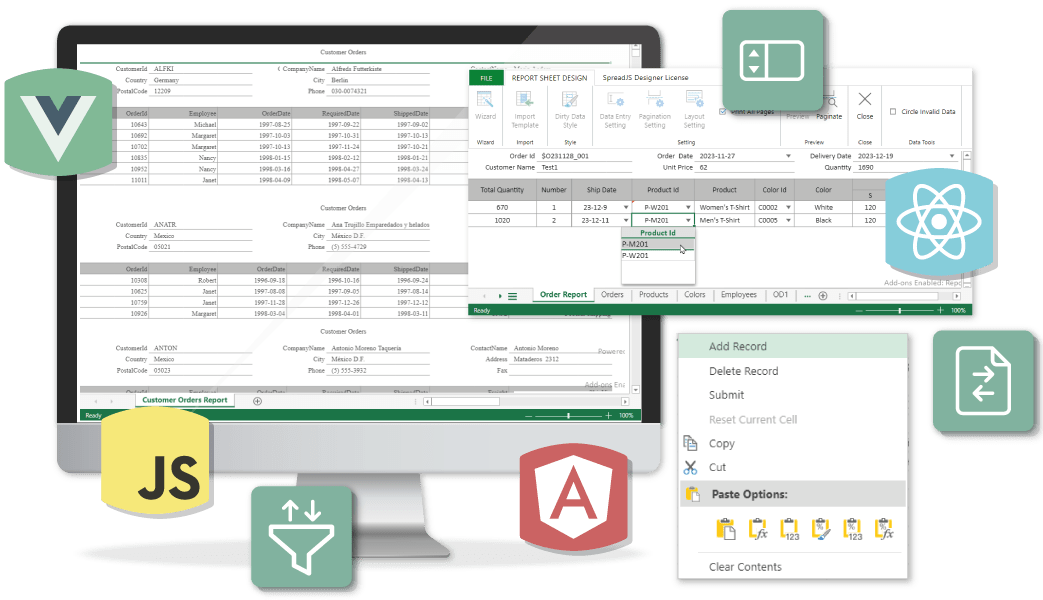
Waterfall Charts
We have added a new chart type to SpreadJS: the Waterfall chart. This shows a running total as values that are added or subtracted. These values are arranged as columns with positive and negative values and are color-coded to distinguish between the two. The initial and final columns are typically aligned against the horizontal axis, whereas the intermediate values are typically floating columns.
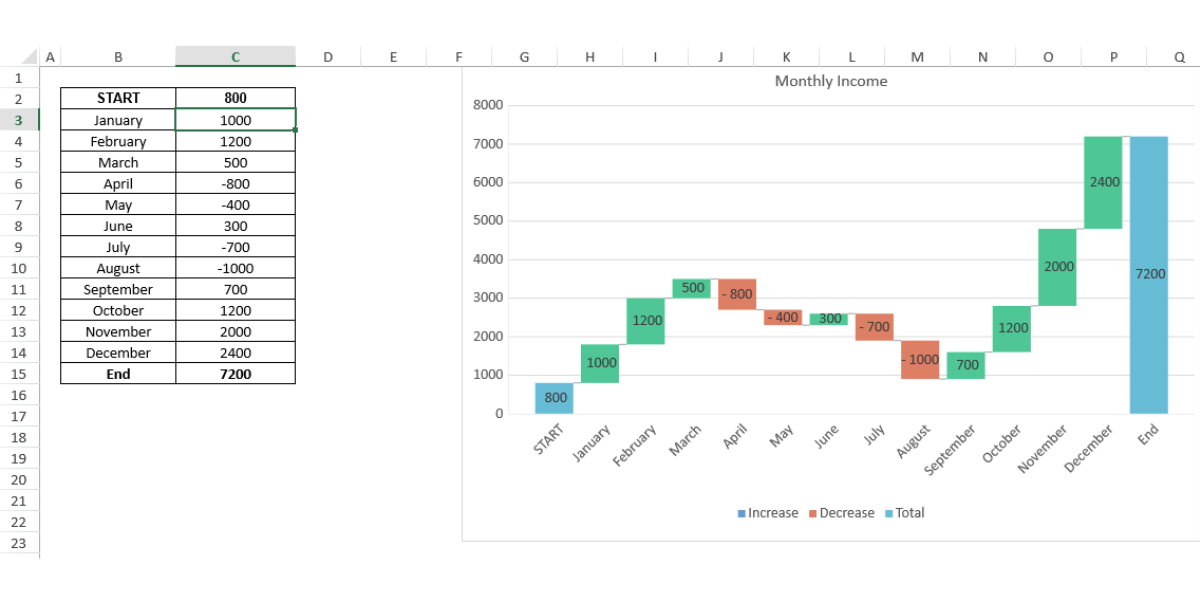
Smooth Lines Format for Line Charts
Line charts in SpreadJS now support formatting with smooth lines.
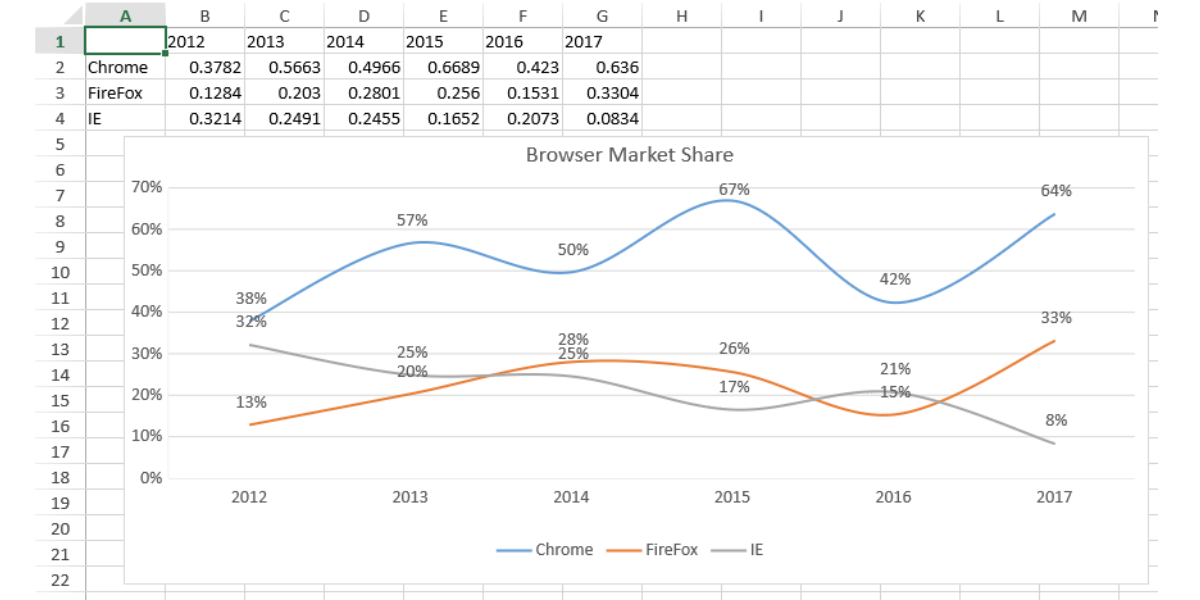
Inserting Charts with Multi-Selections?
Similar to Excel, SpreadJS now supports inserting charts using multi-selections. In addition to selecting a continuous area of data, you can now also press the Ctrl key to select multiple, non-contiguous areas to create a chart. You can also specify multiple ranges in code by placing a comma between each range:
sheet.charts.add("chart1", GC.Spread.Sheets.Charts.ChartType.columnClustered, 0, 100, 400, 300, "Sheet1!$A$1:$C$4,Sheet1!$E$3:$G$3,Sheet2!$A$1:$A$3");These ranges can be specified in multiple ways, and SpreadJS will create the chart accordingly:
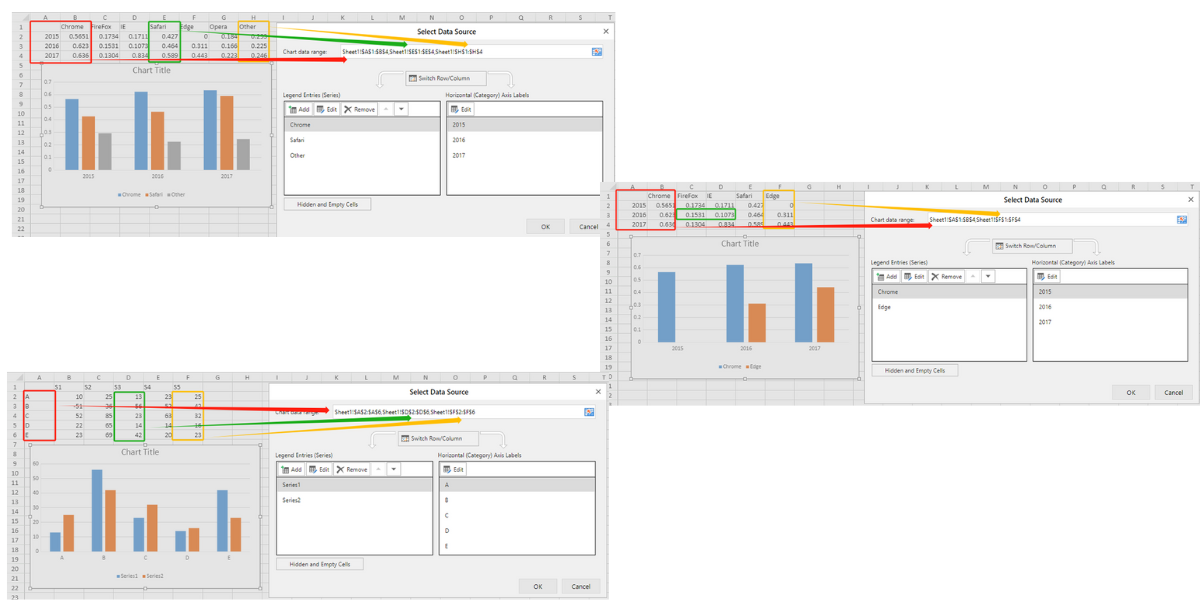
Shape-Based Chart Rendering?
Charts have been reworked to be shape-based rather than DOM-based. This is more of an internal change, and existing charts will not be affected, but there is now more support for Z-Order management, grouping, and connecting with other shapes.
Workbook Enhancements
Additional Paste Special Options
SpreadJS now supports even more paste special options, including:
- Comments - Paste only comments
- Validation - Paste only data validation rules
- All using Source theme - Paste all cell contents in the same worksheet theme
- All except borders - Paste all cell contents and formatting except for the borders
- Column Widths - Paste the width of one copied column or range of columns
- Formulas and Number Formats - Paste only formulas and all number formatting options
- Values and Number Formats - Paste only values and all number formatting options
Sheet Tabs Style Support
Sheet tabs now support styles that the user can set. The style includes the text style, background color, and icon.
Extending Custom Table Column Style
Custom table column styles are now propagated properly when tables auto-expand.
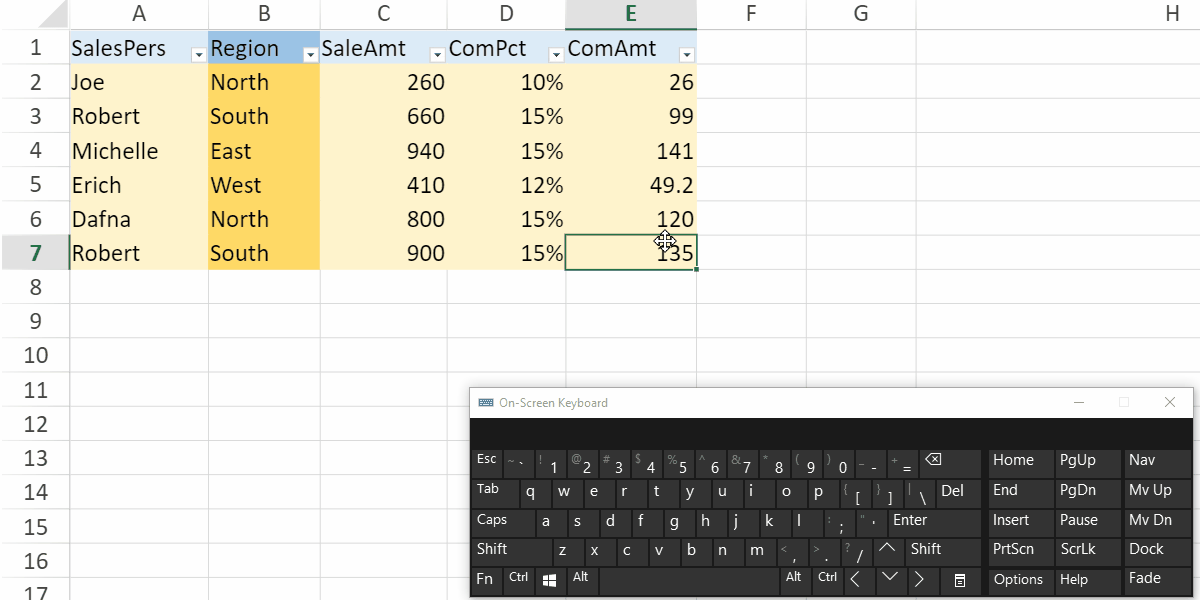
TopRowChanged/LeftColumnChanged Event Enhancement
The TopRowChanged and LeftColumnChanged events now support pixel scrolling. Before this change, the entire row or column would have to be scrolled before the event would fire, but now it will fire and provide the scrolling status for any change in the scrolling when pixel scrolling is enabled.
Distributed Horizontal Alignment
SpreadJS now supports Distributed Horizontal Alignment for text. This is simple to the Center alignment, except it will also wrap text automatically.
Preserve Last Excel Sort State
When importing Excel files, SpreadJS now preserves the sort condition so that it is not lost.
Calculation Enhancements
IMAGE Function Update
The IMAGE function has been updated to match Excel’s implementation. This change includes changing the order of parameters as well as adding the?alt_text?and?sizing?parameters.
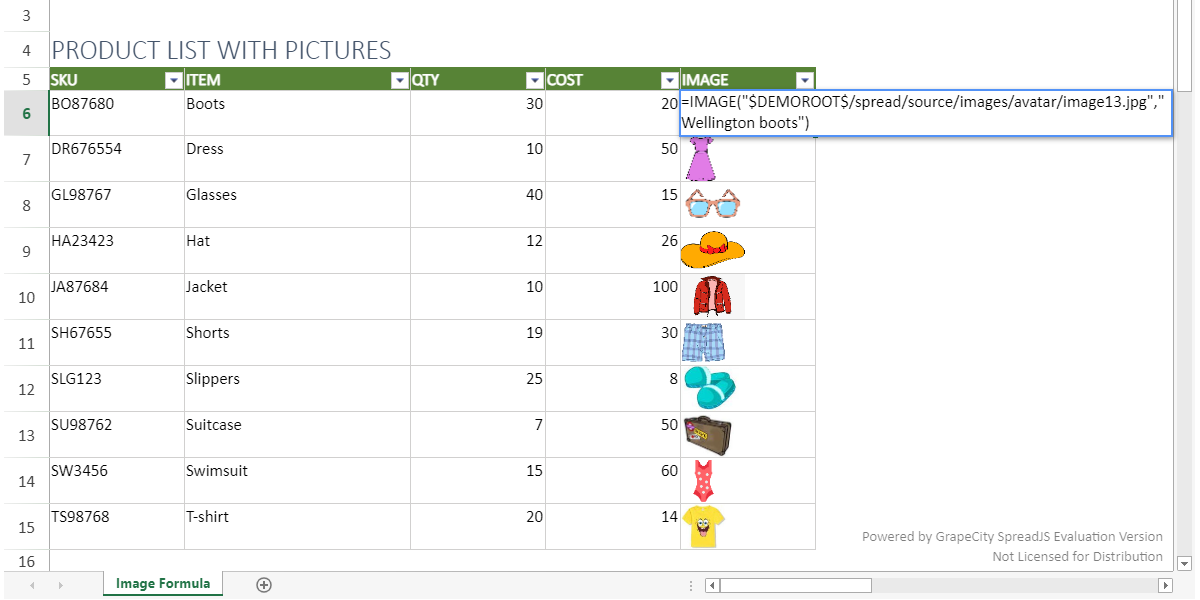
Window Functions Enhancements
The TableSheet Window function has also been updated to include the?FrameGroups?frame type and the?Exclude?parameter. The FrameGroups frame type is defined by groups as the starting and ending boundaries of the frame. The Exclude parameter is an optional parameter that lets you exclude rows or groups from a frame.
PivotTable Enhancements
Split Font Options
We have split the font options into different properties to better support PivotTable and Table font options in Excel. Normally, the?font?property on a cell can be used to set all of the font options, but we have also provided API to set the individual font options like?fontFamily, fontSize, fontWeight,?and?fontStyle:
// Font
activeSheet.getCell(2, 0).font('italic normal 12px Mangal');
activeSheet.getCell(4, 0).font('normal bold 15px Arial Black');
activeSheet.getCell(6, 0).font('normal normal 18px Georgia');
// FontFamily
activeSheet.getCell(2, 1).fontFamily('Mangal');
activeSheet.getCell(4, 1).fontFamily('Arial Black');
activeSheet.getCell(6, 1).fontFamily('Georgia');
// FontSize
activeSheet.getCell(2, 2).fontSize('12px');
activeSheet.getCell(4, 2).fontSize('20px');
activeSheet.getCell(6, 2).fontSize('28px');
// FontWeight
activeSheet.getCell(2, 3).fontWeight('bold');
activeSheet.getCell(4, 3).fontWeight('normal');
// Italic
activeSheet.getCell(2, 4).fontStyle('italic');
activeSheet.getCell(4, 4).fontStyle('normal');PivotArea Offset Support?
SpreadJS now provides an?offset?property to style specific PivotAreas in a PivotTable. You can use this offset to specify the row, column, rowCount, and colCount of the area that you want to style:
let style = new GC.Spread.Sheets.Style();
style.backColor = "rgb(247, 167, 17)";
let labelPivotAreaWithOffset = {
labelOnly: true,
references: [{
fieldName: "Salesperson",
items: ["Alan"]
}],
offset: {
row: 1,
col: 0,
rowCount: 3,
colCount: 1
}
};
pivotTable.setStyle(labelPivotAreaWithOffset, style);
let cornerPivotAreaWithOffset = {
type: GC.Spread.Pivot.PivotAreaType.corner,
offset: {
row: 0,
col: 1,
rowCount: 1,
colCount: 1
}
};
pivotTable.setStyle(cornerPivotAreaWithOffset, style);
let topRightPivotAreaWithOffset = {
type: GC.Spread.Pivot.PivotAreaType.topRight,
offset: {
row: 0,
col: 0,
rowCount: 1,
colCount: 4
}
};
pivotTable.setStyle(topRightPivotAreaWithOffset, style);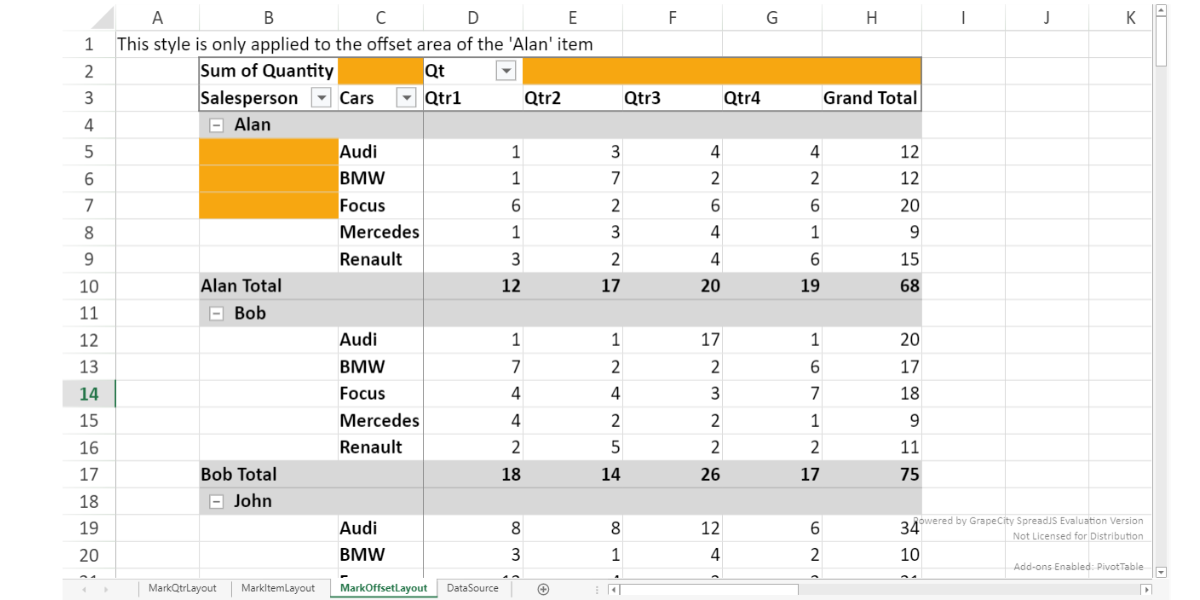
TableSheet Enhancements
Reference Calculated Fields
The DataManager supports adding fields from a data source, but it also now supports virtual columns with a?formula?data type. These formula columns can then be used in the?View?of a TableSheet to show things like a Running Sum or a Stock Value Ratio:
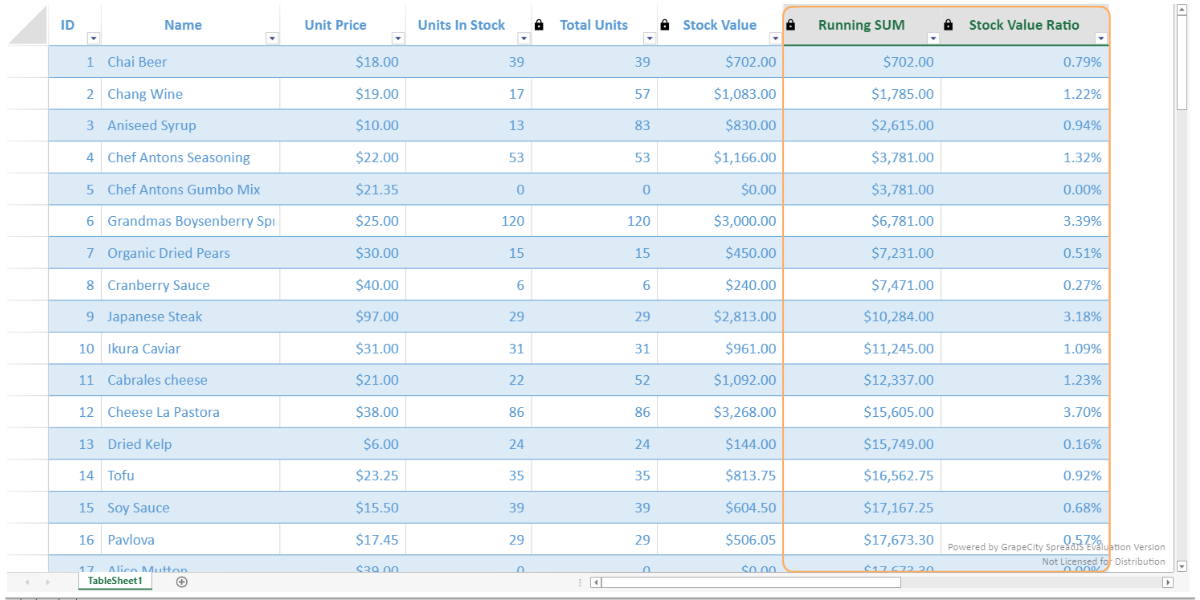
// Add product table.
var productTable = dataManager.addTable("productTable", {
remote: {
read: {
url: baseApiUrl + "/Product"
}
},
schema: {
columns: {
TotalUnits: {
dataType: "formula",
value: "[@UnitsInStock] + [@UnitsOnOrder]"
},
StockValue: {
dataType: "formula",
value: "[@UnitPrice] * ([@TotalUnits])"
}
}
}
});
// Bind a view to the table sheet
var myView = productTable.addView("myView", [
{ value: "Id", caption: "ID", width: 50 },
{ value: "ProductName", caption: "Name", width: 170 },
{ value: "UnitPrice", caption: "Unit Price", style: { formatter: "$#,##0.00" }, width: 120 },
{ value: "UnitsInStock", caption: "Units In Stock", width: 120 },
{ value: "TotalUnits", caption: "Total Units", width: 120 },
{ value: "StockValue", caption: "Stock Value", style: { formatter: "$#,##0.00" }, width: 120 },
{ value: "=SUM([#1:@[UnitPrice]]*([#1:@[UnitsInStock]]+[#1:@[UnitsOnOrder]])", caption: "Running SUM", style: { formatter: "$#,##0.00" }, width: 150 },
{ value: "=[@StockValue]/SUM([UnitPrice] * ([UnitsInStock] + [UnitsOnOrder]))", caption: "Stock Value Ratio", style: { formatter: "0.00%" }, width: 160 }
]);Trigger Formulas for Columns
Trigger Formulas in a TableSheet are formulas that calculate according to specific conditions or triggers. This means you can recalculate data based on specific conditions, clean data when a new value is entered, or provide a default value for a column. Here are a few examples of trigger formulas:
var table = dataManager.addTable("Table", {
schema: {
columns: {
createdDate: {
dataType: "Date",
trigger: {
when: "onNew", <<------- apply the formula on created
formula: "=NOW()", <<------- trigger formula to set current time
// fields: "*" <<------- when triggered on new, there is no need to specify the affected fields
},
},
updatedDate: {
dataType: "Date",
trigger: {
when: "onNewAndUpdate", <<------- apply the formula on created and updated
formula: "=NOW()", <<------- trigger formula to set current time
fields: "*" <<------- all fields changed will have the formula applied to them
},
},
label: {
trigger: {
when: "onNewAndUpdate", <<------- apply the formula on updated
formula: "=UPPER([@label])" <<------- use the upper formula on the input text of the label field
fields: "label", <<------- when the current column value is updated the formula will be applied
},
},
amount: {
dataType: "number",
trigger: {
when: "onNewAndUpdate", <<------- apply the formula on updated
formula: "=[@price] * [@quantity]" <<------- automatically evaluate the amount
fields: "price,quantity", <<------- the changes of the price and quantity columns will cause the formula to calculate
},
},
price: { dataType: 'number' },
quantity: { dataType: 'number' }
},
}
});
Sparkline Enhancement
Lollipop Variance Sparkline
The new Lollipop Variance Sparkline lets you show absolute and relative variances in a dataset. It is similar to a bar chart but reduces the display space by using lines instead of rectangles. As a result, they are more useful when dealing with large amounts of data.
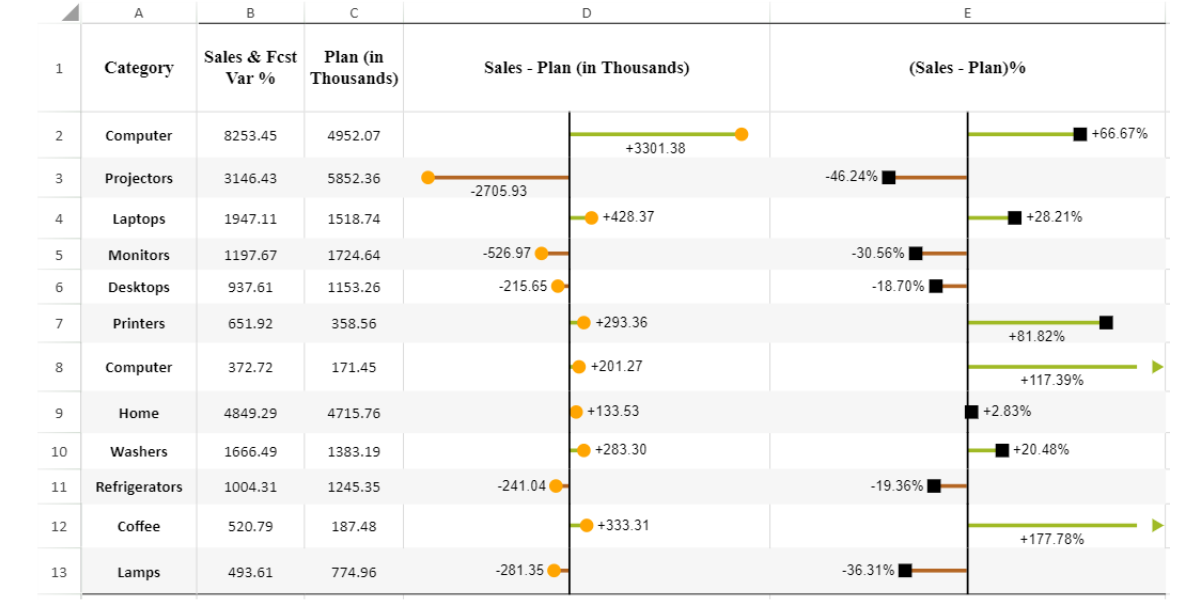
本文来自互联网用户投稿,该文观点仅代表作者本人,不代表本站立场。本站仅提供信息存储空间服务,不拥有所有权,不承担相关法律责任。 如若内容造成侵权/违法违规/事实不符,请联系我的编程经验分享网邮箱:chenni525@qq.com进行投诉反馈,一经查实,立即删除!
- Python教程
- 深入理解 MySQL 中的 HAVING 关键字和聚合函数
- Qt之QChar编码(1)
- MyBatis入门基础篇
- 用Python脚本实现FFmpeg批量转换
- 拒绝小胖墩,给孩子最好的礼物就是健康
- 奇怪!IF:12.0,备受国人肯定的TOP快刊,竟仍位列中科院2区席位?
- 绩效管理工作你做对了吗?
- 深入解析JavaScript属性的getter和setter
- Volatile关键字原理
- 运维必存的20个常见的故障排查、修复大全
- 【卫星科普】什么是农业一号卫星和农业二号卫星?
- Apache Doris (五十九): Doris - BITMAP精准去重
- chatGPT的Function calling示例
- JS的作用域链是静态的,它的取值是在创建阶段而不是调用阶段